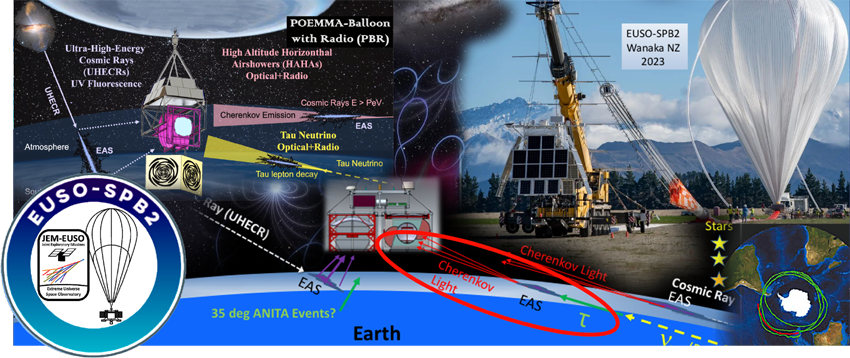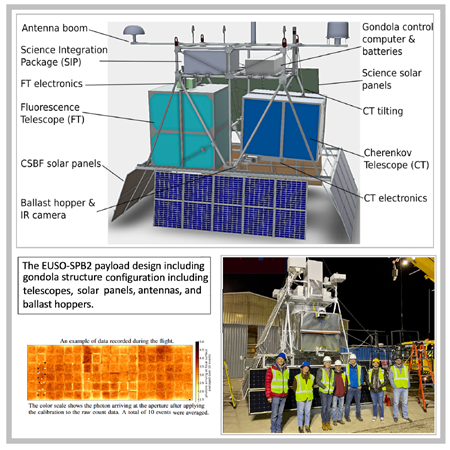
EUSO-SPB2, the superpressure baloon two of JEM-EUSO studying cosmic rays.
The Super Pressure Balloon 2 (SPB2) is part of the Joint Experiment Missions for Extreme Universe Space Observatory (JEM-EUSO) program, studying and observing cosmic rays, from space, at the highest energies (Ultra High Energy Cosmic Rays, UHECRs), with energy above 10^7 Tera-Electrovolt (TeV).
EUSO-SPB2 is a long-duration, suborbital balloon, flight experiment in the stratosphere, following the flights of EUSO-Balloon (2014) and EUSO-SPB1 (2017). UHECRs are detected through two large-field Schmidt-type mirror telescopes, respectively through the fluorescence technique and the Čherenkov radiation produced by neutrinos of very/ultra high energy (VHE/UHE, 10^4-10^5 TeV). This is an experiment precursor of the next POEMMA (Probe Of Extreme Multi-Messenger Astrophysics with Radio, PBR) balloon, with launch planned in 2027.
The telescope detects fluorescence light of UHECRs incident in the upper atmosphere, is pointed to Earth’s nadir. On the other hand, the Čherenkov telescope, optimized for fast (10 ns) signals from Extensive Air Showers (EAS) produced by neutrinos grazing the Earth, is pointed at the edge (“limb”) of the Earth. The SPB2 flight of 2023, launched from Wanaka in New Zealand, has been subject to a major flaw in the balloon: hundreds of Cherenkov event data are obtained, while fluorescence data have not sufficient statistics.

The group of INFN Rome Tor Vergata section is working on the SPB2 Čherenkov data analysis, in calibration of Mini-EUSO, and building hardware for the next PBR (SiPM detectors for gamma-ray and X-ray photons, readout and trigger systems, Field Programmable Gate Array logic devices). PBR is a new stratospheric science balloon optimized for a flight on a next NASA Super-Pressure Balloon (SPB), at an altitude of 33km, with a 1.1-meter Schmidt telescope with dual focal surfaces, for fluorescence and Čherenkov detection, in addition to X-ray and gamma-ray photon detectors, and a radio antenna optimized for EASs in the 50-500 Mhz radio-band range. Beyond UHECRs and UHE neutrinos, the PBR experiment will be able to detect multi-messenger astrophysical transients such as GRBs and gravitational wave bursts, during an about 3-month flight.
























































































